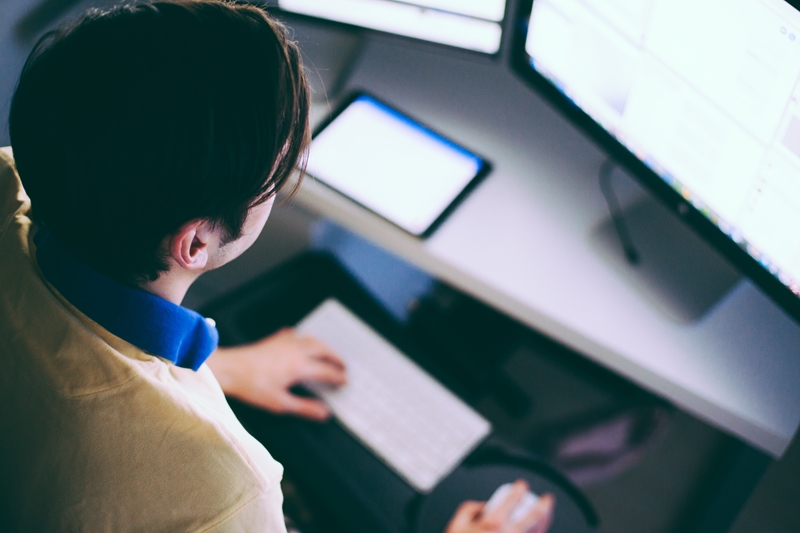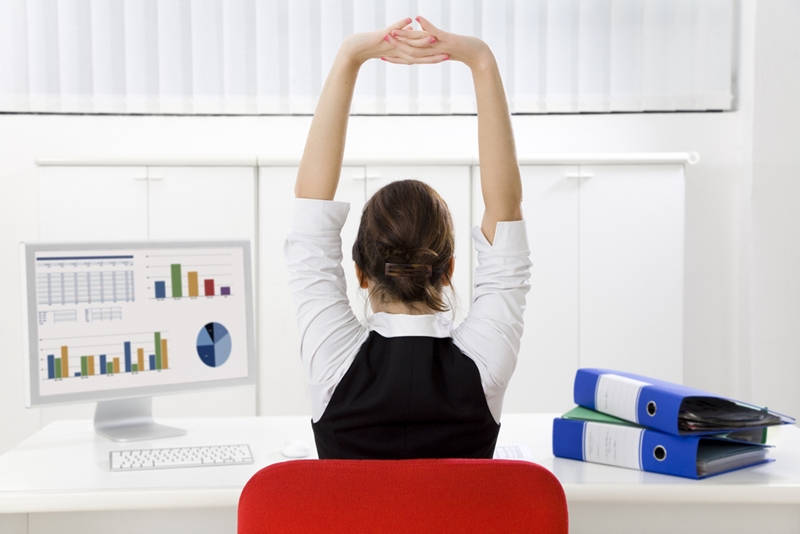Stiff muscles, a sore neck, tired eyes and back pain - these are all symptoms of working behind a desk. There are also hidden side effects such as a slower metabolism and poor circulation. Research from Canada also discovered a link between prolonged periods of sitting and increased risk of heart disease, cancer and diabetes. If you spend most of your day typing reports, crafting spreadsheets or otherwise stuck behind a desk, use these tips to avoid the back pain and exit the office in a good mood:
Adjust your monitor
Staring at a screen that's too high or too low for eight hours means an evening of neck pain. Time Magazine advised adjusting your monitor so the top of it meets your line of sight. This way, you look down slightly to see the screen - about 10 degrees - but your neck is still in line with your spine. Lowering your monitor too much causes you to slouch, but placing it too high leads to dry eyes.
 Adjust your computer monitor so the top falls right at your eye line.
Adjust your computer monitor so the top falls right at your eye line.
Keep your wrists straight
Typing all day puts you at risk for wrist injuries, carpal tunnel syndrome and ganglion cysts. Straighten your wrists by angling your keyboard upward. This puts your arms at a slight incline, forcing your wrists to remain straight.
Sit, don't slouch
Set your chair at a height that allows your feet to rest flat on the floor while keeping your knees bent at a right angle. If you're given a choice in seating arrangements, choose a chair that curves to support your lower back. If not, purchase a lumbar cushion. Both options are designed to follow the spine's natural curve. Keep your back against the chair and align your shoulders with your pelvis to maintain good posture.
Keep your desk clean
Clutter stresses people out. According to Psychology Today, all the objects scattered across your desk are just excess stimuli for your brain to process, ultimately distracting you and and increasing your anxiety. Keep your desk as organized as possible with folders, notebooks and a container for stray pens.
Stretch often
Although good posture helps combat the side effects of sitting for long periods of time, it doesn't negate them completely. Take a few moments to stretch every hour or so, and your muscles will thank you. The University of California at Santa Cruz listed some helpful moves for your entire body, including your fingers, shoulders, neck, legs and even your face. Hold each stretch for a few seconds, and try not to bounce in and out of the position. Stretch far enough to release tension in the muscles, but not so far that you start to feel pain.
 Stretching periodically keeps your muscles from getting stiff.
Stretching periodically keeps your muscles from getting stiff.
Get up and move
Staying in the same spot for hours on end is only useful when you're meditating. At work, it can alter your posture, cause low back pain and slow your metabolism. The easiest way to get moving is to leave the desk for a quick stroll around the office, but try to get some fresh air if you can. The sunlight and resulting vitamin D will give you a nice energy boost and restore your mood for the rest of the workday.
If walking isn't feasible, take advantage of your office break room and do a short round of calisthenics. A few minutes of jumping jacks, squat jumps, pushups and crunches warms your muscles and gets your heart elevated, sending blood rushing through your body and lubricating your joints.
You might feel weird adding a pillow to your desk chair or taking a stretch break every hour, but don't let the embarrassment keep you from prioritizing your health. Who knows - you might become a trailblazer in the office and inspire others to take care of themselves as well.